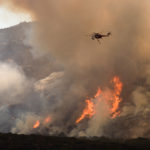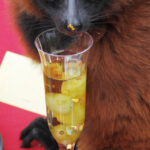On a crisp Saturday in October I’m standing behind the bar at Byington Vineyard & Winery while pouring wine for
a lively bachelorette party. I ask the ladies how they managed to find the bright pink Hummer limousine that dropped them off right at our door. One of the women, embarrassed, grins and explains it was their only option for a chauffeur with such short notice.
She goes on to say they originally planned to be in Napa this weekend. But, since wildfires were currently devastating the area, they scrambled to plan their weekend for a nearby and presumably safer wine region – the Santa Cruz Mountains. This was great news for our little winery, but was this a sign of things to come for Northern California’s most famous wine region?
It’s no secret that climate change is affecting vineyard regions around the world. Northern California is a clear example of this, where climate change sparks concern that someday this region may no longer be the home of American wines.
“I think Oregon is going to be the new California,” says Andrew Brenkwitz, who has been the head winemaker for Byington Vineyard & Winery in the Santa Cruz Mountains. He’s been making wine in this region, about 80 miles south of Napa, for the past 17 years.
Scientists partially attribute the rapid spread of October’s fires in Napa to climate change – hotter and drier than average conditions created the perfect fuel for disastrous fires. But climate change is also creating more perpetual concerns for California winegrowers.

The varieties of wine grown in California may be completely different in the next 50 years thanks to rising temperatures.
According to Greg Jones, a climatologist at Linfield College in Oregon, wine growing regions in Northern California experienced an increase of nearly 0.5 degrees in average growing season temperature (April to October) between 1950 and 1999.
Jones predicts if the temperature in Napa continues to increase for the next 50 years, “then the growing environment there would be unlike anything we know wine grapes to be able to be produced in.”
Temperature is the biggest environmental factor affecting wine flavor. The higher the temperature, the faster the grapes produce sugar – which turns to alcohol during fermentation – and polyphenols – chemicals that create flavor.
Denis Hoey, winemaker, and owner of Odonata Wines in Santa Cruz, California, says he likes the berry flavors from warmer weather grapes, but the extra sugar in the grapes means the wine is higher in alcohol. Making those wines is “a balancing act – it adjusts everything we do,” he says.
Although rising temperature is the trend over time, increasing annual temperature variability is also a concern, says geographer Tony Shaw, at Brock University in Ontario, Canada.
Winemakers strive to produce consistent quality wines year after year. Shaw says “the challenge for the grower is to be able to anticipate what is likely to happen,” and make necessary changes to their vineyard practices.
Hoey waters his vineyards as much as possible to “help the vines curb a heat wave,” but sometimes water isn’t enough to slow down the ripening process. He says after warmer than average summers, as in recent years, he harvests the grapes much earlier in the year than he did just a decade ago.
Fortunately for wine drinkers, the challenges of climate change have yet to hinder the enthusiasm of passionate winemakers like Brenkwitz and Hoey. Instead, Brenkwitz says it’s all part of why he loves making wine – “Every day brings something new.”







Comments are closed.